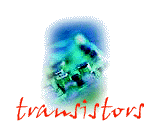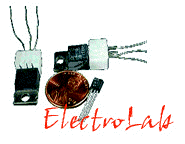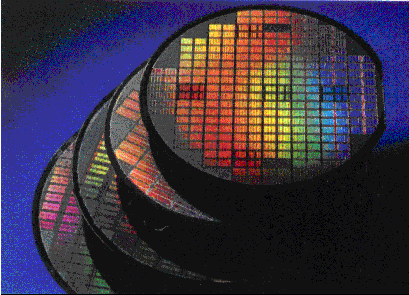






![]()
T
he integrated chip: a tiny wafer of silicon no bigger than one centimeter by one centimeter. Taking this into account, it is unbelievable think that each of these minute chips can contain as many as a million transistors. In fact, it is not only transistors that can be found on these remarkable silicon chips, but also entire electrical circuits, comprising numerous transistors, wires, and other electrical devices.If a person was to try and make all the components which make up
an integrated chip oneself and connect them manually, it would take an entire year, but
using special machinery, manufacturers around the world turn out millions every second.
The first integrated chips were built by Jack Kilby and Robert Noyce (alongside),
and since their invention in 1958, have been developed steadily.
The integrated chip is made up of a number of different layers placed one on top of the other. This is a complicated process involving placing masks with particular patterns over the chip and then changing the properties of the silicon. Alternatively, the areas that the mask does not cover are filled with a metal or insulator. The chip is made out of a semiconductor crystal, starting out as a thin layer of P-type silicon. The different layers are then added using a complicated process. Layers of a material known as silicon dioxide are added, followed by a special chemical called photoresist.
 The photoresist, when illuminated by a special
pattern of light then turns hard. The other bits of photoresist not illuminated by the
light stay soft. A special etching chemical is then used to remove these soft areas, as
well as the sulphur dioxide below them. The hard photoresist is then removed, leaving a
pattern of raised silicon dioxide along the surface. It doesn't conduct electricity, it
keeps different parts of the final circuit separated from others. Polysilicon, which does
conduct electricity is then added. Afterwards, projected photoresist masks are used to
dope areas of the chip to become N-type silicon, another part which is crucial in a
transistor. Metal leads are then used to connect the various components. Integrated chips,
because they are so tiny, are usually made in bulk, with hundreds made on a single silicon
wafer at once.
The
wafer is then cut up into smaller pieces.
The photoresist, when illuminated by a special
pattern of light then turns hard. The other bits of photoresist not illuminated by the
light stay soft. A special etching chemical is then used to remove these soft areas, as
well as the sulphur dioxide below them. The hard photoresist is then removed, leaving a
pattern of raised silicon dioxide along the surface. It doesn't conduct electricity, it
keeps different parts of the final circuit separated from others. Polysilicon, which does
conduct electricity is then added. Afterwards, projected photoresist masks are used to
dope areas of the chip to become N-type silicon, another part which is crucial in a
transistor. Metal leads are then used to connect the various components. Integrated chips,
because they are so tiny, are usually made in bulk, with hundreds made on a single silicon
wafer at once.
The
wafer is then cut up into smaller pieces.